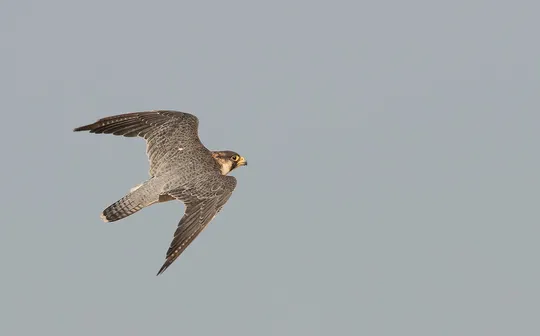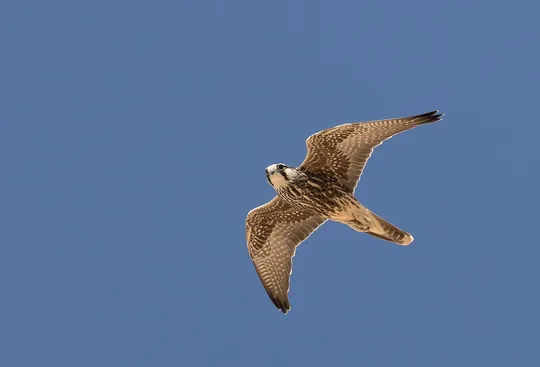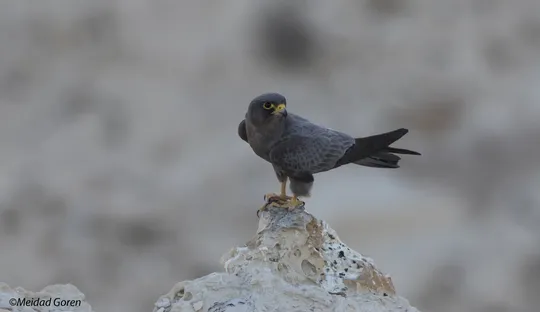Falco subbuteo
 Endangered
Endangered
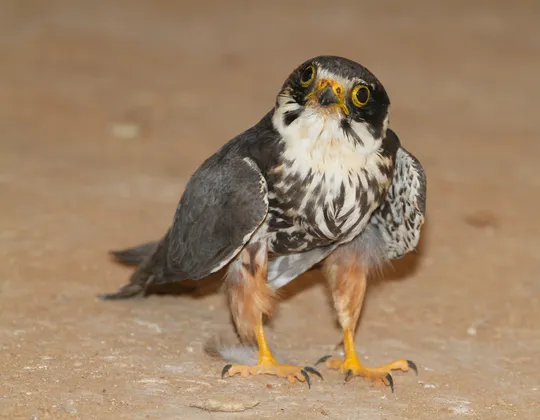
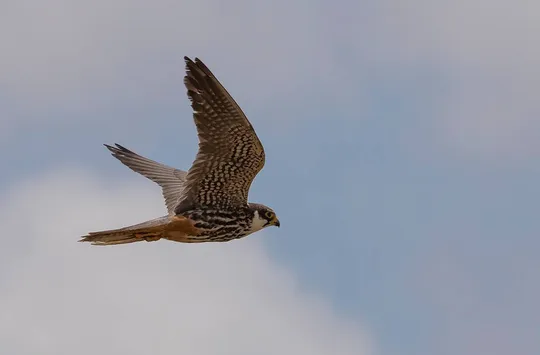
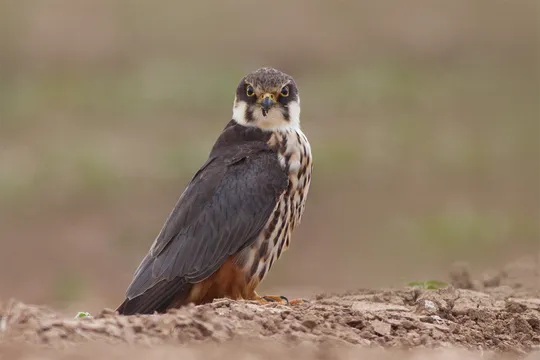
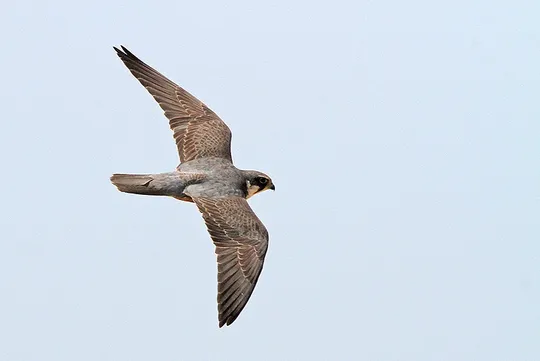
| Habitats | Parks & Woodlands, Mediterranean Maquis, Rural Areas |
|---|---|
| Presence In Israel | Summer, Migrant |
| Breeding In Israel | Breeder |
| Migration Types | Long Range |
| Zoographical Zones | Mediterranean, Irano-Turanian |
| Landscape Types | Plains & Valleys, Rural Area |
| Vegetation Types | Forest, Mediterranean Maquis, Parks |
| Vegetation Densities | Medium |
| Nest Locations | Tree |
| Diet Types | Terrestrial Vertebrates |
| Foraging Grounds | Aerial |
| Body Sizes | Small (up to 500g) |
| Threat Factors | Unknown |
The Eurasian Hobby is a small, delicate, agile and restless falcon that specializes in hunting insects, birds and bats in flight. With its long scythe-shaped wings, it resembles a large heavy swift. This allows it to spend extensive time in the air and to maneuver rapidly similar to the swifts and swallows that are a major component of its prey.
The Eurasian Hobby summers in the Mediterranean region and in the Northern Negev and migrates in small numbers over the entire country. It breeds in northern and central Israel, south to the Nitsana and Mashabbe Sade area, and in the Jordan Valley down to Jericho. It arrives in Israel in March-April and leaves from late August to mid-October. Its range overlaps the range of the Hooded Crow, whose abandoned nests it uses. During the past decades, its range has extended south to the central Negev, in the wake of Hooded Crow expansion. Despite its expansion southwards there is a decrease in population density in its core areas in northern and central Israel, so that its total numbers have decreased considerably.
Inhabits partially open areas, such as flatlands and fields with scattered trees, rural settlements with tall trees, and woodland and forests interspersed with open areas. It is usually seen flying over trees or fields. Winters in savanna landscapes in Africa.
We do not know the factors threatening Eurasian Hobbies. As the species also nests in rural and agricultural areas that have not changed significantly over the past two decades (on the contrary, conditions may even have improved, thanks to the maturation of planted groves, particularly eucalyptus trees, and the increase in Hooded Crows in whose nests it breeds). Therefore, it is probably negatively affected by factors along its migration route and wintering grounds.
No specific conservation measures have been taken for this species to date.
The Eurasian Hobby is classified as an endangered species because of the pronounced decrease in its population size. Its threat factors are unknown; therefore, it is highly recommended to initiate research to obtain a more precise assessment of the breeding population size, migration patterns and the factors threatening the species.
As the factors threatening the Eurasian Hobby are unknown, research and monitoring to gather these data should be conducted.
The Eurasian Hobby feeds mainly on insects and birds it hunts in flight. Insects are caught in agile flight and transferred from its feet to beak while gliding with spread wings. Its flight is more rapid and focused when hunting birds. It flies rapidly, low to the ground, attempting to surprise birds and make them fly up, catching them in the air, often after an intensive prolonged chase. Occasionally it hunts at songbird flock roosts, or at bat roosts, catching them when they leave in the evening. The nesting season is from mid-May to September. Eggs are laid in abandoned Hooded Crow nests on tall trees and in the Northern Negev on utility poles as well.
- אזוב, א. 2001. עקב חורף בגליל העליון. דו"ח עבור רשות הטבע והגנים.
- אזוב, א. 2010. תוצאות סקר עקב חורף בגליל העליון. דו"ח עבור רשות הטבע והגנים.
- לשם, י. 1979. העופות הדורסים בישראל. הוצאת החברה להגנת הטבע.
- פז, ע. 1986. עופות. מתוך אלון, ע. (עורך), החי והצומח של ארץ ישראל. כרך 6. הוצאת משרד הביטחון, ישראל.
- Shirihai, H., 1996. The Birds of Israel. Academic Press, London.
- Symes, A. 2013. Species generation lengths. Unpublished, BirdLife International.
- Species page at Birdlife International
Current Occupancy Map
| Data Missing | Sporadic | Limited Sites | Low Density | High Density |
|---|---|---|---|---|
| 0 | 0 | 0 | 0 | 0 |
Distribution maps
The maps presented here provide visual information on the distribution of species in Israel from the past and present, and the changes in occupancy and breeding density during the comparison period. For further reading
Relative Abundance 2010-2020
Breeding density values in the current decade as determined from experts' opinion and observations from databases.
| Data Missing | Sporadic | Limited Sites | Low Density | High Density |
|---|---|---|---|---|
| 8 | 12 | 12 | 21 | 19 |
Relative Abundance 1980-1990
Density values based primarily on the book The Birds of Israel (Shirihai 1996).
| Data Missing | Sporadic | Limited Sites | Low Density | High Density |
|---|---|---|---|---|
| 5 | 14 | 14 | 17 | 22 |
Occupancy 1990-2020
The map shows differences in the species breeding distribution between the 1980's breeding map and the current weighted breeding evaluation. Negative value - species previously bred in the grid and is not presently breeding; positive value - species has not previously bred in the grid and is currently breeding.
| Data Missing | No Change | Occupancy Increase | Occupancy Decrease |
|---|---|---|---|
| 6 | 35 | 1 | 9 |
Change in Relative Abundance 1990-2020
The map shows the changes in the relative abundance of a species in each of the distribution grids between the breeding map of the 1980s and the weighted current breeding evaluation. Negative values - decline in abundance; positive values - increase in abundance; zero - no change in abundance.
| 80 to 100 | 50 | 20 to 30 | No Change | 30- to 20- | 50- | 100- to 80- | Data Missing |
|---|---|---|---|---|---|---|---|
| 0 | 4 | 2 | 22 | 12 | 14 | 11 | 16 |
| Rarity | |
|---|---|
| Vulnerability | |
| Attractiveness | |
| Endemism | |
| Red number | |
| Peripherality | |
| IUCN category | |
| Threat Definition according to the red book |
 Contributed:
Contributed: 